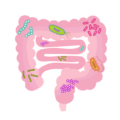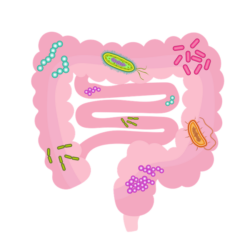Several months ago, a colleague let me know that his patients were testing positive for oxythiamine. He had begun using IV thiamine at his clinic based upon our book: Thiamine Deficiency Disease, Dysautonomia, and High Calorie Malnutrition and was seeing remarkable results in some patients. In others though, recovery was much more difficult and he wanted to know why. He began testing various components of the thiamine pathways searching for a pattern. These tests included oxythiamine, an anti-thiamine molecule. I am not sure what drove him to consider oxythiamine, as neither of us knew much about it at the time except that it was used experimentally to initiate thiamine deficiency in animals, but whatever it was, it was an inspired move.
Most our knowledge about this molecule comes from experimental work where oxythiamine, and another anti-thiamine molecule called pyrithiamine, are used in animal research to induce thiamine deficiency. Based upon the animal research, I mistakenly assumed these were entirely synthetic compounds, that they had not been observed in humans, and thus, were not produced by the body. I was wrong. It turns out that high concentrations of oxythiamine have been measured in adults and children with late or end stage kidney disease. There is some speculation, beyond my own, that it may be synthesized endogenously. In contrast, while pyrithiamine, to my knowledge, has not been measured in humans, there is some evidence that certain microbes are capable of synthesizing it from thiamine pyrophosphate – the active form of thiamine. This suggests to me that it too may be present in the humans within which these microbes reside.
Although much of this is speculative, if either of these anti-thiamine molecules are proven to be synthesized endogenously, it would point to yet another set of mechanisms by which someone may become functionally deficient. That is, with endogenous synthesis of either oxythiamine or pyrithiamine, one might appear to have sufficient thiamine, when in reality, anti-thiamine molecules are counteracting or outright blocking the effects of this vitamin. This discovery may also point us towards a more thorough understanding of how diet affects metabolism. Here, I believe, excessive fructose consumption, in the form of high fructose corn syrup (HFCS), is a key trigger for endogenous oxythiamine and possibly pyrithiamine synthesis. At this point though, the fructose>oxythiamine and pyrithiamine connections are purely conjecture on my part. Although I have much still to figure out, below is what I have learned so far.
Why Thiamine?
Thiamine or vitamin B1 is a cofactor for enzymes involved in the metabolism of foods into energy and into other substrates required for the synthesis of RNA, DNA. For this reason, it is critically important for survival for all organisms, from bacteria to mammals. Thiamine deficiency impairs mitochondrial function, the organelles responsible for suppling energy to cells within the body. It also modulates how the body governs protein synthesis and cell growth and how the body regulates oxygenation. As such, inadequate thiamine in humans causes a laundry list of illnesses ranging from fatigue and metabolic disorders to dysautonomia and brain damage. Thiamine deficiency is most commonly known by the end stage disorders known as beriberi, Wernicke’s encephalopathy and Korsakoff’s syndrome, but in reality, it is a disease process that emerges years earlier. We have published extensively on the effects of thiamine deficiency (here).
What Are Oxythiamine and Pyrithiamine?
Oxythiamine
Oxythiamine is molecule that competitively inhibits the thiamine dependent enzyme transketolase (TKT). This means that it competes with thiamine for binding opportunities on the TKT enzyme to control the activity of the enzyme. When oxythiamine binds to TKT, it inhibits or turns off the enzyme. When thiamine binds to the enzyme, however, the enzyme is activated. Oxythiamine does not appear to cross the blood brain barrier, and for this reason, it is believed to exert most of its actions in the body. It can affect thiamine transport to the brain and reduce total thiamine stores, but most of its activity appears to be in the body.
Some studies have found that high dose oxythiamine also competitively inhibits the pyruvate dehydrogenase enzyme complex (PDC), the alpha-ketoglutarate dehydrogenase enzyme complex (aKGDH), as well as some non-thiamine dependent enzymes like 6-phosphogluconate dehydrogenase and NADP-dependent malate dehydrogenase. Interestingly, it appears to inhibit these enzymes early, before inhibiting TKT. Perhaps the reduced functioning of these enzyme influences the downregulation of the TKT enzyme?
The main action of oxythiamine, however, is believed to be the inhibition of the TKT enzyme. The TKT enzyme connects the glycolytic pathway (anaerobic metabolism, secondary energy pathway) to the oxidative pathway (aerobic metabolism – major energy pathway). It is also critical to for the functioning of what is called the pentose phosphate pathway (PPP), where substrates like ribose to make RNA, DNA, and reduced equivalents of nicotinamide adenine dinucleotide phosphate (NADPH) for steroid hydroxylation, fatty acid synthesis (myelin), and antioxidant enzymes (glutathione and thioredoxin) are synthesized . While these pathways produce some ATP, their primary role is synthesizing substrates for other functions, notably those used in protein synthesis and cell growth. The PPP is especially important for rapid cell growth, as is required for immune cell proliferation, but also, for onco- and tumorigenesis. For this reason, the use of oxythiamine as a cancer treatment has been explored. Oxythiamine has also been considered as an adjunct for antibiotic resistant pathogens. It seems to be particularly potent against the malaria parasite. For obvious (or perhaps not so obvious reasons, as it continues to be proposed), oxythiamine has not been used in humans, that I am aware of.
Pyrithiamine
Pyrithiamine, on the other hand, prevents the phosphorylation/activation of thiamine both in the brain and the body, and hence produces a more profound deficiency. Thiamine consumed from diet – free thiamine- has to be phosphorylated into thiamine pyrophosphate (TPP), also called thiamine diphosphate (ThDP) in order to be usable by the body. The enzyme that mediates this action is called thiamine pyrophosphokinase (TPK). When we block the TPK enzymes that activate thiamine, we have little to no usable thiamine. If we then reduce or eliminate thiamine from diet, as in the experimental models of deficiency, we get a rapid decline in health, which inevitably means death.
A side note of potential interest: recently published research demonstrates a link between TPK defects in certain regions of the brain and Huntington’s disease. Since the deficiency observed in Huntington’s confined to a specific region of the brain, this suggests to me that there may be some degree of regional specificity with somewhat distinct isoforms of the enzyme. This has yet to be determined, however. Regardless, these same researchers that identified the TPK defects, also found that high dose thiamine compensated for the genetic defects and ameliorated symptoms.
Experimental Thiamine Deficiency
Experimentally, when oxythiamine is used to produce thiamine deficiency, the key patterns of deficiency involve anorexia and lethargy in the animals.
In contrast, when pyrithiamine is used, there is evidence of central and peripheral nervous system damage. In rodents, neurologic signs such as seizures, loss of the righting reflex, decreased spontaneous movements, and opisthotonos (muscle spasms and backwards arching) develops fairly quickly, usually within 2 weeks. In mice, within 10 days. This corresponds to approximately a year in human lifespan and highlights the extended trajectory of deficiency to symptoms and death.
These behaviors noted in animal research correspond with brain damage in patterns similar to those observed with human Wernicke’s encephalopathy.
In other words, oxythiamine-induced thiamine deficiency presents much like wet beriberi, while pyrithiamine induced thiamine deficiency presents much more like classical Wernicke’s encephalopathy, neurologic signs such as ‘seizures, loss of the righting reflex, decreased spontaneous movements, and opisthotonos’.
Oxythiamine and Pyrithiamine in Real Life
As I mentioned above, high concentrations of oxythiamine have been found in patients with later and end stage kidney disease. Some researchers speculate that oxythiamine comes from diet, and is present in foods with low pH such as fruits, fruit juices, canned fruits heated during commercial processing, or foods made acidic by vinegar, lemon juice, and other acidic additives. They posit that oxythiamine is not synthesized endogenously but rather ingested. Another group posits that “increased production of oxythiamine by gut microflora in patients with ESRD” is more likely.
While both are entirely plausible, perhaps even likely, I suspect oxythiamine may be synthesized endogenously both microbially and intracellularly in response to the consumption of these types foods, especially when consumed with regularity and to the point of depleting thiamine. I suspect that this is the case for pyrithiamine as well, although admittedly, I have no real evidence beyond the fact that certain microbes can produce the molecule in vitro.
Where Does This Leave Us?
Well, it seems to me, that all of this points directly towards the need for better nutrition. If we consider when these molecules might be synthesized endogenously or even consumed via food products, we arrive squarely in the land of ultra-processed foods. Ultra-processed foods are high in fructose, highly acidic, carry a high toxicant load and are low in thiamine. Diets of comprised of these foods contribute not only to the metabolic dysfunction that leads to diabetes and a host of other conditions endemic to modernity, but when sufficiently chronic or severe, to kidney disease, where oxythiamine has been measured. Along the way though, and before frank kidney disease appears, we get gut dysbiosis and with that a higher frequency of infection and other illnesses.
Among the questions all of this research poses, perhaps the most important is why would we synthesize molecules that are so obviously deleterious to health? I cannot answer that now, but I believe these molecules serve some survival function, first as potential substrates for thiamine itself, when thiamine availability is diminished, and second as some sort of compensatory mechanism against uncontrolled cell growth, such as with cancer, and I suspect, though I have evidence for this, with disturbed immune reactivity (autoimmunity). It is also possible that in grand scheme of microbial balance, the synthesis of these molecules is somehow ultimately anti-microbial. In other words, perhaps these molecules are involved not only in the synthesis of energy absent thiamine, but also in the demise the various microbes that use this pathway. I do not know, but I will continue to investigate. For now though, oxythiamine and possibly pyrithiamine may be synthesized endogenously and in response to high fructose diets.
We Need Your Help
More people than ever are reading Hormones Matter, a testament to the need for independent voices in health and medicine. We are not funded and accept limited advertising. Unlike many health sites, we don’t force you to purchase a subscription. We believe health information should be open to all. If you read Hormones Matter, and like it, please help support it. Contribute now.
Yes, I would like to support Hormones Matter.
Photo by Emily Morter on Unsplash.
















Hi Dr Marrs, I’ve often wondered if there’s a connection between thiamine and malaria, and when I looked into it, I found references to the anti-parasitic effect of oxythiamine. Here’s one example:
https://biology.anu.edu.au/news-events/news/thiamine-utilisation-antimalarial-drug-target
I wonder if endogenous production of oxythiamine could be an evolutionary response to malaria and the like?
It is possible that oxythiamine is a protective mechanism against a variety of microbes and/or the unfettered cell growth of cancer.